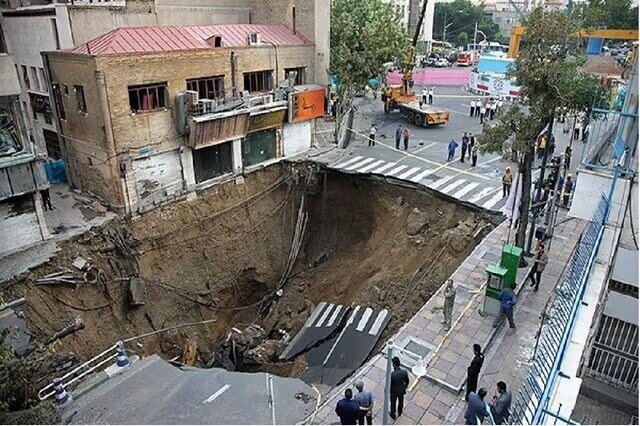Widespread land subsidence: a national crisis
Water security, a global issue

TEHRAN – Water supply in Iran largely depends on rainfall, snowmelt, and underground aquifers, but decades of over-extraction have left groundwater resources severely depleted. While the global water resources are stretched by climate change and human population growth, the farms and industries are increasingly turning to groundwater to fill their needs.
Unfortunately, pumping of groundwater can cause the ground surface to sink as aquifers below are drained and the architecture of the ground collapses. This phenomenon is also called land subsidence. This article attempts to introduce the phenomenon and the underlying causes, mainly in Tehran:
With a population of over 15 million residents, including a large floating populace, Tehran is now on the precipice of a severe land subsidence crisis. Established in 1953, the National Cartographic Center (NCC) of Iran has proved its role as the main leader of map production and spatial information in the country. According to Iran’s NCC, some regions are sinking at alarming rates of 31cm per year, wreaking havoc on the vital infrastructure and historical sites, making it a national crisis. Cracked homes, tilting mosques, and endangering historical sites like the ancient ruins of Persepolis are some of the examples. Even a modern infrastructure like the Imam Khomeini International Airport has not escaped the adverse effects of land subsidence.
According to another source, scientists from the GFZ German Research Center for Geosciences in Potsdam used satellite data to reveal the extent of the subsidence. The team used a tool known as Interferometric Synthetic Aperture Radar (InSAR), which can spot even the most minute difference in ground deformation. They revealed that land around Imam Khomeini International Airport (IKIA) was sinking at around 5 centimeters per year – which unfortunately was one of the more moderate areas of subsidence.
This crisis is unlike earthquakes or severe weather phenomena that make media and TV coverage on an international scale. Land subsidence is invisible because it occurs at a very slow pace, but its impact cannot be ignored.
Other causes for this phenomenon are attributed to scarcity of rainfalls, uneven distribution of water, high climatic variation, and mismanagement of the precious water resource. Subsidence is also associated with mining. Demographic factors such as the population explosion is also cited. Just about 50 years ago, Tehran had a population of only two million. The rapid expansion of the urban population has made the task of water distribution even more difficult.
The Amirkabir Dam, which passes through the Karaj River, has shrunk by seven percent to 22.09 billion cubic meters, a spokesman of the Iranian Water Resources Management Company Isa Bozorgzadeh was quoted recently. The concrete dam, 30 km northwest of capital, was built in 1961 to supply Tehran with water and electricity.
Latyan Dam is a buttress dam located less than 25 km from Tehran, south of the city of Lavasan. Constructed between 1963 and 1967, it is one of the main sources of water and electricity for Tehran. With a capacity of 95 million cubic meters, the dam has been operational since 1967.
Seventy percent of Tehran’s water comes from five nearby dams, including Amirkabir and Latyan. According to the state media reports, as of March 5, the reservoirs are only 13 percent full.
A look back five years ago, in May of 2019, Mehr news agency reported that Amirkabir Dam was 93 percent full, an increase of four percent compared to the year before. The significant improvements were attributed to the exceptional water torrents that spring that covered almost all provinces after six decades.
Unfortunately, this year water shortage has also been due to the low precipitation, which the Ministry of Energy has said barely reached 93.8mm from early October to mid-March, a dramatic shortfall from the national average of 157.8mm, a 60 percent reduction.
Under the circumstances, reduction of water use, minimization of waste, and recycling of water are good first steps. Optimization of water usage is bound to reduce the water consumption and can reduce the overextraction of groundwater.
Last year, President Masoud Pezeshkian called for the relocation of Iran’s political and economic center away from Tehran, citing the capital’s mounting environmental and infrastructural challenges.
“We have no choice but to move the country’s political and economic center closer to the southern waters,” he said, adding that the current development trends in Tehran are unsustainable, particularly given the city’s water scarcity.
“Whatever we do, we're just wasting time. We have no choice but to move the country's economic and political center to the south, closer to the sea," he said.
Given Tehran’s large population and being the economic heart of the country, the air pollution has become part of this problem. The quality of air in the capital contaminates the water storage in the form of ice on the mountain to the rivers downstream.
The underlying cause of this crisis stems from groundwater over-extraction, rising from 10 cubic meters per second in 2020 to 17.5 in 2023. Although it decreased to 14.5 in 2024, these levels remain unsustainable.
Without immediate reforms in water management and infrastructure planning, the capital city faces escalating risks to its infrastructure, heritage sites, and population.
The unsustainable global practices for managing water resources will eventually lead to tighter restrictions and supply cuts. It will make today’s uninterrupted and never-ending supply of water look like a dream.
While today’s global wars are on land and energy resources, the future wars will inevitably be fought over a more vital resource.
Photo: A view of the effects of land subsidence in the capital Tehran.
Leave a Comment